As I said in my video on the history of 3-phase electricity, both Nikola Tesla and Galileo Ferraris discovered two-phase electricity and the two-phase motor that were, according to Tesla, “identical almost to the smallest detail.” 1 So, how did these two men develop this fantastic discovery?
Table of Contents
Introduction
How Ferraris Got Involved
Ferraris’ Influence
How Arago’s Wheel might have inspired Tesla
How Two-phase was developed
References
Introduction
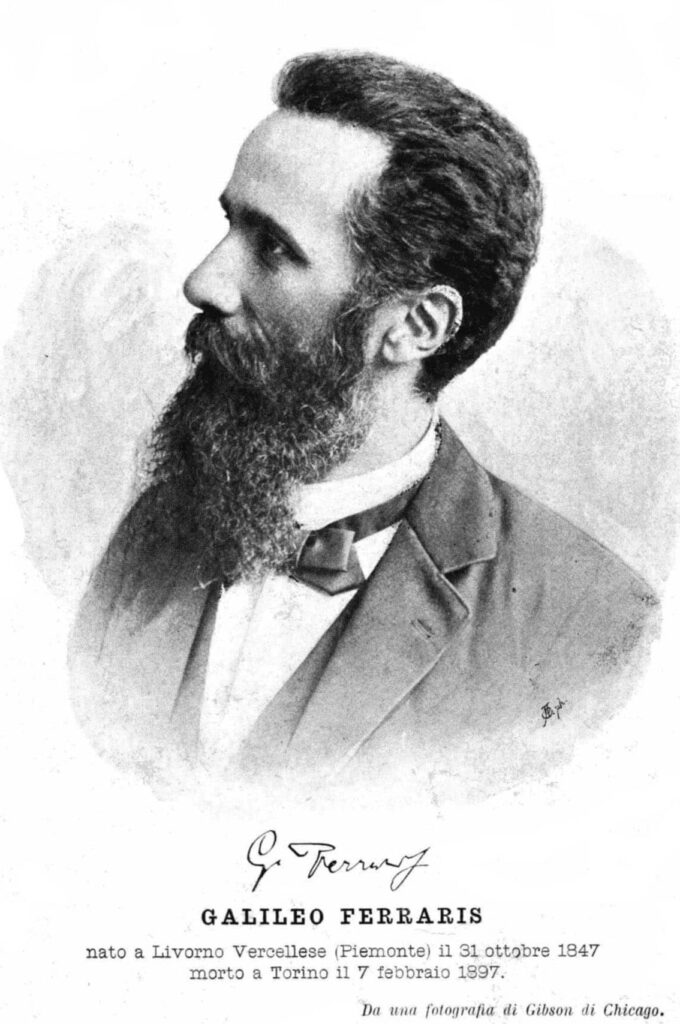
Let me start with Galileo Ferraris in 1884. At the time, Ferraris was a 37-year-old Physics professor and was the president of the electricity exposition at Turin. 2
This is important because, at that fair in September 1884, a Frenchman named Lucien Gaulard and his financial backer John Gibbs demonstrated how they could transmit AC electricity what was considered a long distance, around 30 km or 20 miles from a waterfall
at Lanzo to Turin 3 at low loss.
This was only possible because they transmitted the electricity at high voltage and low current and then used what they called a “secondary generator” (or what we would now call a transformer) to change it to lower voltages and higher current to operate safely for electrical systems.
Ferraris was impressed and awarded them a prize from the Italian government. By January 1885, Ferraris conducted his studies and published a paper on the topic titled “Researches on Gaulard and Gibbs Secondary Generators.” 4
How Ferraris Got Involved
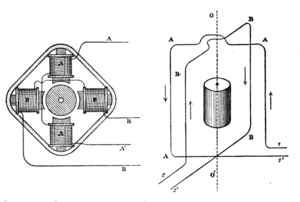
Ferraris’ results were so impressive that if it weren’t for his high standing in science he would not have been believed!
However, his report made clear to at least one author at the time that, “as far as alternating currents are concerned, the question of distributing electrical energy over a large area from a central station has here found a satisfactory solution.” 5
Ferraris knew that this transformer (and the better one made months later by the ZBD group) made AC more viable than DC for long distance electrical power transmission but he also knew that one of the issues with AC is that they did not have a motor or meter.2
Then, sometime in early 1885, Ferraris was teaching about polarization of light and he was inspired to make a two-phase AC motor.
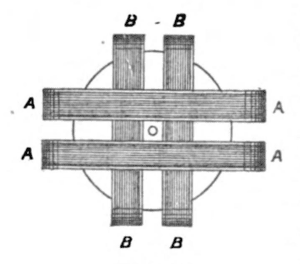
See, Ferraris knew from the equations of James Clerk Maxwell that light was an electromagnetic wave and the direction that the electric field is vibrating in is called the polarization of the light: if the electric field vibrates horizontally, it is horizontally polarized, and if it vibrates vertically, it is vertically polarized.
Ferraris also knew that if one combines horizontally polarized light and vertically polarized light that is in phase (gets bigger and smaller at the same time) then one produces diagonally polarized light.
However, if one combines light 90 degrees (or a quarter wave) out of phase, then the result
is a wave where the electric field moves in a circle, or circularly polarized light.
In other words, through optics, Ferraris understood that if you combined two waves, one horizontal and one vertical, that are 90
degrees apart, then you get a circular wave and that inspired him to see if he could mimic this effect with electric motors.
Ferraris’ Influence
Ferraris said that in August or September of 1885, he built a hand-cranked generator with two separate coils A & B, so each set of coils got the same current with the same frequencies but only differed in phase (when they increased and decreased in time).
Ferraris then put these coils around a disk, and the two-phase current in the coils induced current in the disk, and was delighted to find that the force between the wind in the disc and the coils caused the disk to spin.
This was possibly the first true brushless polyphase generator and motor ever built. Still, as Ferraris was convinced it wouldn’t make a powerful motor, he mainly just demonstrated it to his students and visitors. 6
It wasn’t until March 18, 1888, that Ferraris published his first paper about using more than one phase in an AC motor or generator. Ferraris was then disturbed to learn that just 2 months later, Nikola Tesla’s patent for a two-phase motor and generator was granted without mentioning Ferraris at all.
In December 1888, a scientist named Alard Du Bois-Reymond wrote an article that stated that “Tesla’s motor” was based on the ideas “invented by Prof. Ferraris of Turin.” 7
This article was translated into English and published in an American magazine in February 1889. Tesla retorted in June 1889 that it was just “one of the most curious coincidences” that “Prof. Ferraris not only came independently to the same theoretical results but in a manner identical almost to the smallest detail.” 8
But how did Tesla come up with the idea of using more than 1 phase of AC to make a motor? This is a difficult question to answer because of Tesla’s personality.
See, Tesla liked to say that his inspirations came fully formed in his head, and he never needed to experiment because “there has not been a single, solitary experiment which did not come out exactly as I thought it would,” 9 and this invention just came from thinking a lot and reciting poetry! However, in lawsuits, Tesla implied that Arago’s Wheel inspired him, 10 so let’s discuss how Arago’s Wheel could have led to a two-phase motor and generator.
How Arago’s Wheel might have inspired Tesla
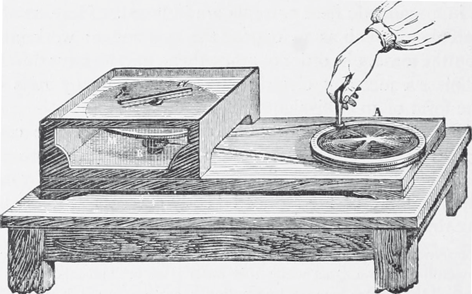
Arago’s wheel was invented in 1824 when a French scientist named François Arago discovered that a spinning copper wheel could spin a nearby magnet with no battery, even though copper is non-magnetic.
The following year, in 1825, English scientists Charles Babbage and John Herschel made a “reverse Arago’s wheel” where they spun a permanent magnet under a copper wheel which caused the copper wheel to turn in sympathy. 11
Fast forward to June of 1879, when an English scientist named Walter Baily was inspired by the reverse Arago’s wheel to make a copper wheel spin with four stationary electromagnets by using a homemade mechanical device to direct the current called a commutator so that the current alternated between the electromagnets. 12
Although this was, arguably, the first two-phase motor, it required a commutator and it wasn’t a motor as much as a tiny classroom demonstration device, measuring only a little over 2 inches wide and 4 inches high. 13
The next year, 1880, a French scientist named Marcel Deprez was inspired by Baily to make a more robust motor that used a similar commutator to Baily’s to electrify a rotor (the part of motor that spins). 14 This was a form of a two-phase motor, but also contained commutators.
How Two-phase was developed

Tesla never admitted that he had read about any of these discoveries, but when he filed for his patent in September of 1887 he did add,
“I am aware that it is not new to produce the rotations of a motor by intermittently shifting the poles of one of its elements.”
However, Tesla correctly added that the previous systems (aside from Ferraris’ which he seemed unaware of), used “mechanical appliances,” where only the direction not the strength of the current changed not the naturally rotating field from a two-phase generator. 15
In 1900, a Judge in Connecticut declared in favor of Tesla’s patent that, “It remained to the genius of Tesla to… transform the toy of Arago into an engine of power.” 16 If Baily and Deprez inspired Tesla and their Arago wheels, his device would be a significant advance from what happened before and worthy of our respect and admiration. However, in my mind, his accomplishment is marred by his unwillingness to acknowledge his inspirations and give credit where it is due.
So that is why and how both Galileo Ferraris and Nikola Tesla conceived of using more than one phase of AC in making an AC motor… Now my video about the history of 3-phase motors and 3-phase 3 wire electrical transmission covers my reasons why Tesla is falsely promoted as the inventor of modern 3-phase and why, but I should probably add that Galileo Ferraris is also occasionally stated as the inventor of 3- phase.
That is because Mikhail Dolivo-Dobrowolsky really liked Ferraris (and disliked Tesla) up to suggesting that polyphase electricity should be called a “Ferraris field,” in August of 1891, 17 and naming him the “Father of 3-phase” during the first public demonstration of 3-phase long distance transmission at the Frankfort Electrical fair.
It was because of this that Ferraris is sometimes known as the “father of 3-phase” which confused some people into thinking that he invented 3-phase, which he did not.
References
https://www.edmundoptics.com/knowledge-center/application-notes/optics/introduction-to-
polarization/ (although the following year he declared that the device made by Zipernowsky, Blathy and
Deri, sometimes known as the ZBD transformer was superior).Maler, Julius 1886
1 “Mr. Nikola Tesla on Alternating Current Motors” The Telegraphic Journal and Electrical Review vol. xxiv
(June 7, 1889) p. 648
2 Hess, A “The Monument to Galileo Ferraris in Turin” Electrical World and Engineer vol. xlii No. 6 (Aug 8,
1903) p. 215-6
3 Bowers, B “Galileo Ferraris and Alternating current” Proceedings of the IEEE vol. 89 no. 5 (May, 2001) p.
790 (Turin to Lanzo)
4 “Ricerche Teoriche e Sperimentali sul Generatore Secondario Gaulard e Gibbs” translated and found in
The Electrician (April 11, 1885) p. 450
5 “Ricerche Teoriche e Sperimentali sul Generatore Secondario Gaulard e Gibbs” translated and found in
The Electrician (April 11, 1885) p. 450
6 In 1903 William Stanley stated, “I myself have seen the original motors, models and drawings made by
Ferraris in 1885, have personally talked with the men who saw these models in operation, and heard
Ferraris explain them at that date” Stanley, W “Tesla Split-Phase Decisions” Electrical World and Engineer
vol. XLI No. 12 (March 21, 1903) p. 486
7 Bois-Reymond, A “On the difficulties in the way of transmitting power by alternating currents” translated
into English and found in The Telegraphic Journal and Electrical Review (Feb 1, 1889) p. 116-7
8 “Mr. Nikola Tesla on Alternating Current Motors” The Telegraphic Journal and Electrical Review vol. xxiv
(June 7, 1889) p. 648
9 “Mr. Tesla’s Address of Acceptance” Electrical Review and Western Electrician vol. 70 (May 26, 1917) p.
881
10 “The Tesla Patents” Electrical Review (September, 1900) vol. 37 No. 12 p. 288
11 Babbage, C and Herschel, J “Account of the repetition of M. Arago’s experiments on the magnetism
manifested by various substances during the act of rotation” (June 16, 1825) Phil Transactions of the Royal
Society vol. 115 p. 480-1
12 Baily, W “A Mode of Producing Arago’s Rotation” (June 1879) Physical Society of London, Journal of
Physics A, vol. 3-4 p. 115
13 Measurements are according to Thomson, S Polyphase Electric Currents (1900) p. 437
14 Thompson, S Polyphase Electric Currents (1900) p. 440 and 69-70
15 Tesla, N “Electrical Transmission of Power” (Oct 12, 1887) Patent: US382280A
16 “The Tesla Patents” Electrical Review (September, 1900) vol. 37 No. 12 p. 290-1
17 “sogenanntes Ferraris’sches oder ‘Dreh’ feld” Dolivo-Dobrowolsky, M “Kraftübertagung mittelst
Wechselströmen von verschiedener Phase” Zietchrift für Elektrotechnik Heft VIII (August 1, 1891) p. 367

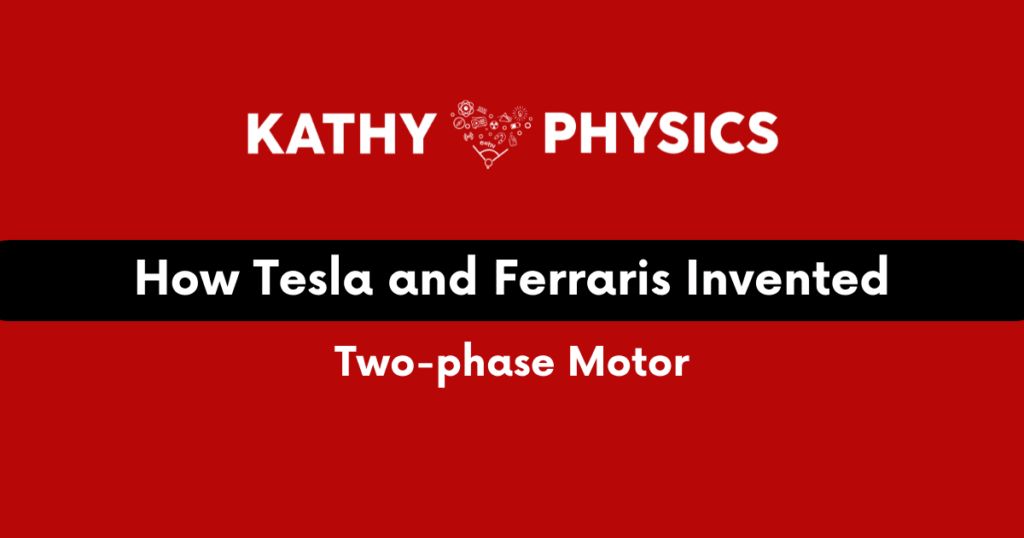
Pingback: Why Doesn't The US Use 220V Like Everyone Else In The World? - Kathy Loves Physics